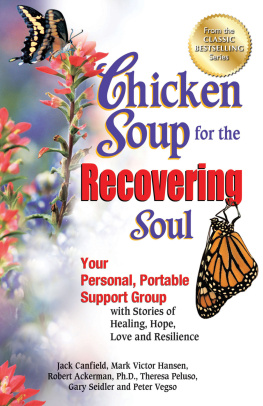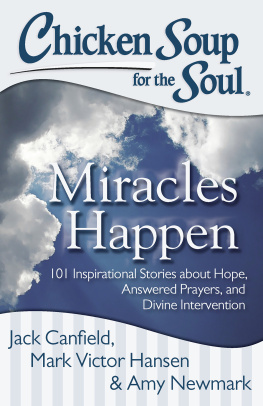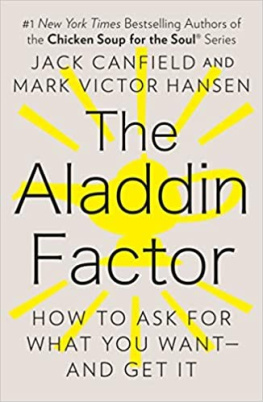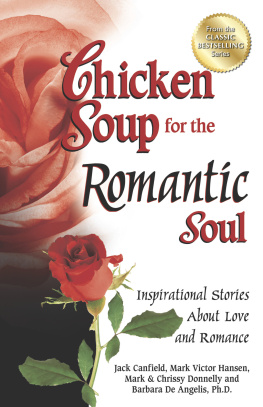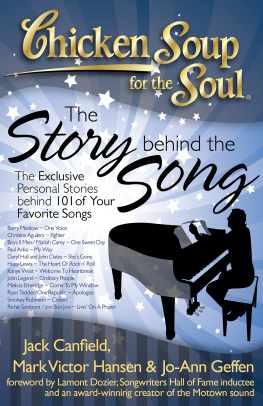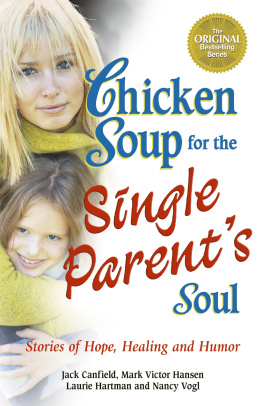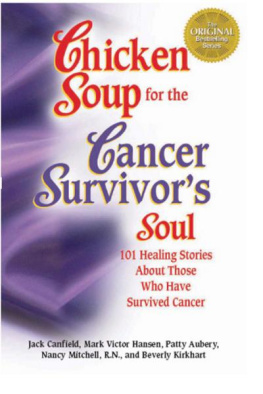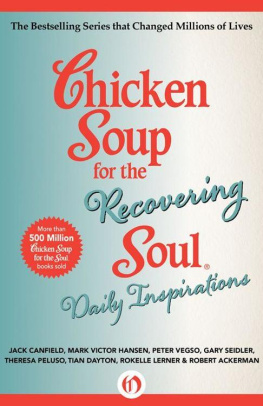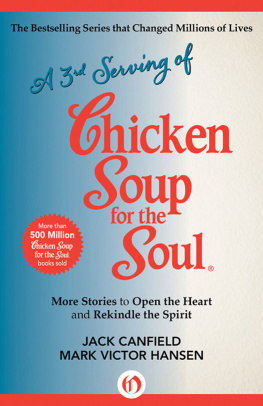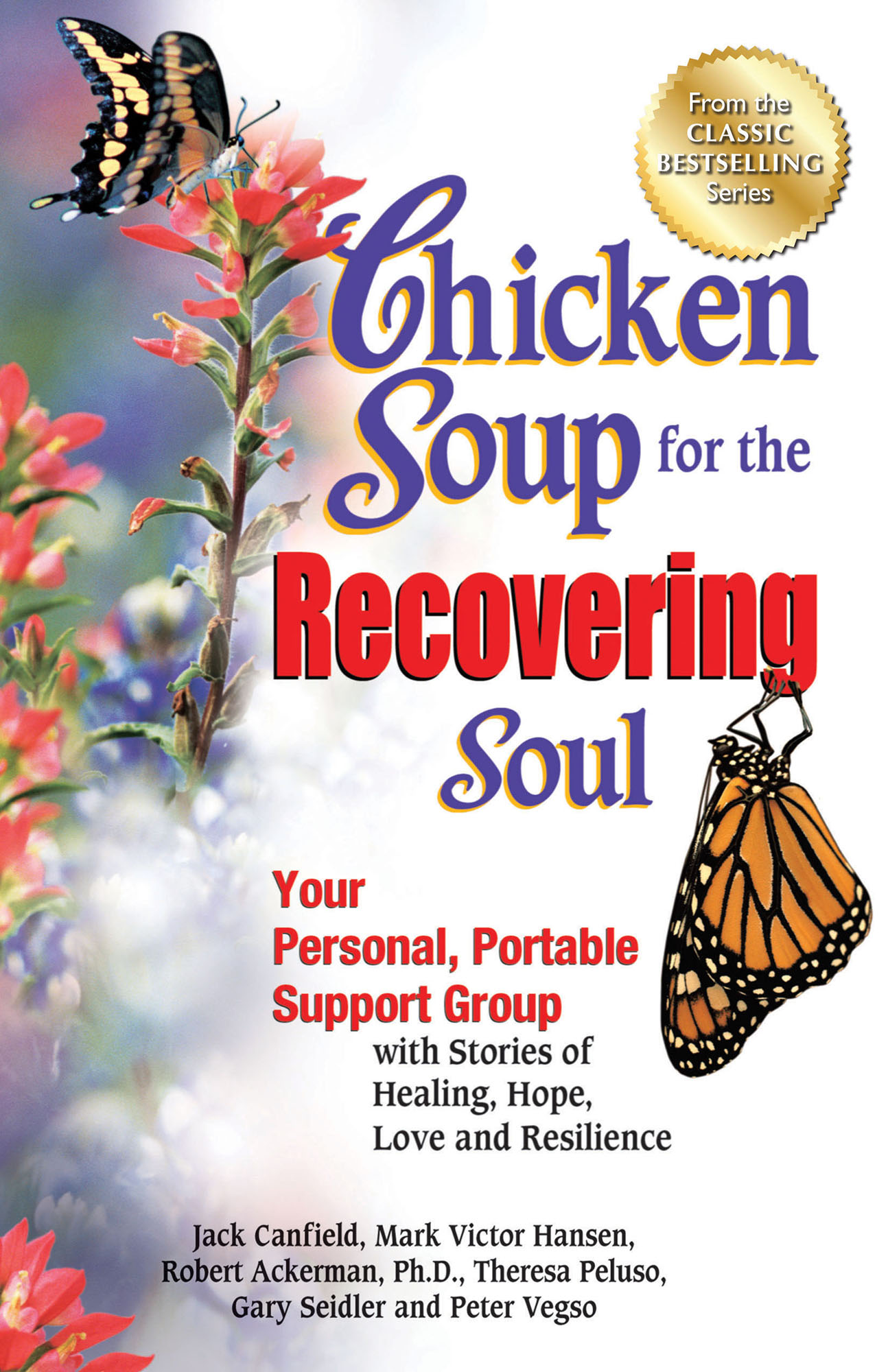CHICKEN SOUP FOR THE RECOVERING SOUL
CHICKEN SOUP
FOR THE
RECOVERING SOUL
Your Personal, Portable Support
Group with Stories of Healing,
Hope, Love and Resilience
Jack Canfield
Mark Victor Hansen
Robert J. Ackerman, Ph.D., Theresa Peluso
Gary Seidler and Peter Vegso

Backlist, LLC, a unit of
Chicken Soup for the Soul Publishing, LLC
Cos Cob, CT
www.chickensoupforthesoul.com
Contents
John Crusey
Jenni Schaefer
Joseph R. Cruse, M.D.
Godwin H. Barton
Kay Conner Pliszka
Jane Middelton-Moz
Elva Stoelers
Julia Jergensen Edelman
Carol J. Bonomo
Janell H.
Linda Day
Sellars Karpek
Anonymous as told to Earnie Larsen
Tracey W. Lee-Coen
Jim C., Jr.
Earnie Larsen
Jann Mitchell
Lee R. McCormick
Andrea W., aka Sala Dayo Nowelile
John Bradshaw
Jayne Thurber-Smith
Cherie Ward
Peter Wright
Rev. Bob Lew
Patricia Holdsworth
Robert J. Ackerman, Ph.D.
John C. Friel, Ph.D.
Anonymous as told to Earnie Larsen
Built Shannon
Lisa J. Schlitt
Loretta McCann Bjorvik
David Mead
Julie Orlando
Jenna Cassell
Rev. Ed Donnally
Earnie Larsen
Loretta McCann Bjorvik
Anonymous
Ted Klontz
Miriam Hill
Mark Sanders
Brian Luke Seaward, Ph.D.
David R. Wilkins
Stuart Brantley
Debra Jay
Robert J. Ackerman, Ph.D.
Theresa Peluso
Arianna Johnson
Raquel M. Strand
Jerry Moe
Jennifer M. Reinsch
Benneth Lee as told to Mark Sanders
Tom Krause
Peter Vegso
Mary Barr
Ann Best
Marilyn Joan
Tom Krause
Carla Riehl
Ted Klontz
Elizabeth Batt
George Roth
Betty King
Steven Manchester
J. Twerski, M.D.
Perry D. Litchfield
Christine Learmonth
Carol Davis Gustke
Emily Schroder
Abraham J. Twerski, M.D.
Lisa Kugler
Terry P.
Sharon Wegscheider-Cruse
Lee-Coen
Erin Hagman
Trimmer Meeks
Cynthia Borris
Rachel Caplin
Debbie Heaton
Sallie A. Rodman
Patricia OGorman, Ph.D.
Linda S. Day
Jaye Lewis
Sherry Diedrich as told to Ruth Coe Chambers
Tian Dayton, Ph.D., T.E.P.
Todd Outcalt
Thom Rutledge
Claudia Black
Anonymous as told to Earnie Larsen
J.I. Kleinberg
Deirdre Morris
Betty King
Jerry Moe
Barbara A. Croce
Elizabeth Walton
History teaches us that no society or generation has gone untouched by alcoholism and addiction. Several hundred years ago, certain Native American tribes were known to have formed sobriety circles. During colonial times in the United States, noted physician Dr. Benjamin Rush, a signer of the Declaration of Independence, began to talk about drunkenness as a disease and called for treatment.
One of the first attempts to deal with alcoholism was not on an individual basis but through mutual support. In 1840, a group of people formed the Washingtonian Society, which at the time was a new and exciting approach. It became so popular that at one point there were 600, 000 members. Also around this time Dr. Magnus Huss, a Swedish physician, officially introduced the term alcoholism. An ongoing debate about the definition of alcoholism ensued and at one time it was thought that as many as 200 different definitions were being used.
Regardless of how it was defined, many institutions were established to help alcoholics. The New York State Inebriate Asylum, the Martha Washington Home in Chicago, and the Water Street Mission in New York City are a few examples. In 1879, Dr. Leslie Keeley began to open more than 120 institutes for addiction treatment in America.
During the Civil War many wounded soldiers were treated with morphine and developed physical dependence on the drug. Their dependence became known as the soldiers disease. Other drug problems surfaced as well, such as cocaine addiction and opiate dependence.
By the turn of the century concern over alcoholism and drug addiction was no longer limited to the addict. Responses to addiction started to develop from the government with such actions as the 1914 Harrison Tax Act to control opiates and cocaine and the involvement of the Supreme Court.
However, all of these efforts did not seem to reach the core of the problem for those struggling with addiction. It was obvious that addiction was not just a physical dependence on a substance and that recovery needed to be more than merely abstinence. For a brief time between 1900 and 1940, an organization known as the Oxford Group attempted to add spirituality to the concept of recovery. Abstinence from alcohol was not a mandatory requirement for this group.
It soon became clear something more was needed. Something that would help people understand they need not recover alone. Something that would help addicts experience not only loss, but also hope. Something that could replace a lifestyle of pain and addiction with one of health and healing and mend a broken spirit, not just a body, to bring peace to a troubled soul.
In the United States, that something emerged in 1935 when two alcoholics, Bill W. and Dr. Bob, found each other and realized that together they could accomplish something that neither of them could do alone. It was the beginning of Alcoholics Anonymous and the beginning of the modern recovery movement. Alcoholics Anonymous (AA) was not the first group of alcoholics to join together, but it quickly became the most explosive and universal. Unlike other groups, its members found something that helped them make sense of their lives, to support each other and to form a community that asked for nothing, but gave much, that welcomed all, judged none, and replaced despair with spirituality and acceptance.
AA offered something even morea way of life. Based on a program of the Twelve Steps of AA and the Twelve Traditions, this way of life was not limited to overcoming your past, but also offered guidelines for living a healthy future physically, emotionally and spiritually. The success of AA quickly spread not only throughout America, but also the world. In fact, many non-alcoholics were attracted to AAs ideas about recovery because of the Twelve Steps and their application to other life situations. Without a doubt, a community had been born and its impact had touched the world.
Other events were unfolding. Universities were beginning to take an interest in trying to better understand addiction and recovery. First among these was Yale, which developed the Center of Alcohol Studies in 1943. In 1944 Marty Mann founded what is known today as the National Council on Alcoholism and Drug Dependence. A tremendous achievement in the treatment of addiction occurred in the late 1940s when three institutions, Pioneer House, Willmar State Hospital and Hazelden developed what is known as the Minnesota Model. Their pioneering work led to the development of 28-day programs for treatment of chemical dependency. It was also around this time that the application of AAs program to other drug addictions emerged with the founding of Narcotics Anonymous (NA).

